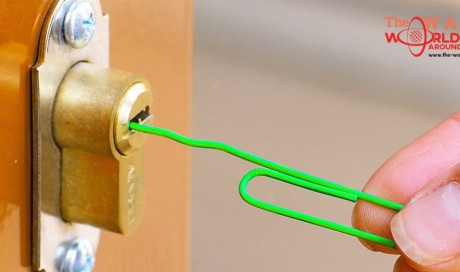The Indian Ocean tsunami of December 2004 caused waves as high as 30 feet (9 meters) in some places, according to news reports. In other places witnesses described a rapid surging of the ocean.
Flooding can extend inland by a thousand feet (300 meters) or more. The enormous energy of a tsunami can lift giant boulders, flip vehicles, and demolish houses. Knowledge of the history of tsunamis in your area is a good indicator of what is likely to happen in a future tsunami event.
• Tsunamis do not necessarily make their final approach to land as a series of giant breaking waves. They may be more like a very rapidly rising tide. This may be accompanied by much underwater turbulence, sucking people under and tossing heavy objects around. Entire beaches have been stripped away by tsunamis.
Many witnesses have said a tsunami sounds like a freight train.
• The 2004 Indian Ocean tsunami could rank as the most devastating on record. More than 200,000 people lost their lives, many of them washed out to sea.
The most damaging tsunami on record before 2004 was the one that killed an estimated 40,000 people in 1782 following an earthquake in the South China Sea. In 1883 some 36,500 people were killed by tsunamis in the South Java Sea, following the eruption of Indonesia's Krakatoa volcano. In northern Chile more than 25,000 people were killed by a tsunami in 1868.
• The Pacific is by far the most active tsunami zone, according to the U.S. National Oceanic and Atmospheric Administration (NOAA). But tsunamis have been generated in other bodies of water, including the Caribbean and Mediterranean Seas, and the Indian and Atlantic Oceans. North Atlantic tsunamis included the tsunami associated with the 1775 Lisbon earthquake that killed as many as 60,000 people in Portugal, Spain, and North Africa. This quake caused a tsunami as high as 23 feet (7 meters) in the Caribbean.
• The Caribbean has been hit by 37 verified tsunamis since 1498. Some were generated locally and others were the result of events far away, such as the earthquake near Portugal. The combined death toll from these Caribbean tsunamis is about 9,500.
• Large tsunami waves were generated in the Marmara Sea in Turkey after the Izmit earthquake of 1999.
Warning Signs
• An earthquake is a natural tsunami warning. If you feel a strong quake do not stay in a place where you are exposed to a tsunami. If you hear of an earthquake be aware of the possibility of a tsunami and listen to the radio or television for additional information. Remember that an earthquake can trigger killer waves thousands of miles across the ocean many hours after the event generated a tsunami.
• Witnesses have reported that an approaching tsunami is sometimes preceded by a noticeable fall or rise in the water level. If you see the ocean receding unusually rapidly or far it's a good sign that a big wave is on its way. Go to high ground immediately.
Many people were killed by the Indian Ocean tsunami because they went down to the beach to view the retreating ocean exposing the seafloor. Experts believe that a receding ocean may give people as much as five minutes' warning to evacuate the area.
• Remember that a tsunami is a series of waves and that the first wave may not be the most dangerous. The danger from a tsunami can last for several hours after the arrival of the first wave. A tsunami wave train may come as a series of surges that are five minutes to an hour apart. The cycle may be marked by a repeated retreat and advance of the ocean. Stay out of danger until you hear it is safe.
Survivors of the Indian Ocean tsunami reported that the sea surged out as fast and as powerfully as it came ashore. Many people were seen being swept out to sea when the ocean retreated.
• A tsunami surge may be small at one point of the shore and large at another point a short distance away. Do not assume that because there is minimal sign of a tsunami in one place it will be like that everywhere else.
• Tsunamis can travel up rivers and streams that lead to the ocean. Stay away from rivers and streams that lead to the ocean as you would stay away from the beach and ocean if there is a tsunami.
• It's always a good idea to keep a store of emergency supplies that include sufficient medications, water, and other essentials sufficient for at least 72 hours. Tsunami, earthquake, hurricane—an emergency can develop with little or no warning.
Advice for Sailors
• NOAA advises that since tsunami wave activity is imperceptible in the open ocean, vessels should not return to port if they are at sea and a tsunami warning has been issued for the area. Tsunamis can cause rapid changes in water level and unpredictable, dangerous currents in harbors and ports. Boat owners may want to take their vessels out to sea if there is time and if the sailors are allowed to do so by port authorities. People should not stay on their boats moored in harbors. Tsunamis often destroy boats and leave them wrecked above the normal waterline.
• Heightened awareness of the potential for a tsunami to inundate the U.S. western coastline has caused NOAA, the U.S. Geological Survey, and the Federal Emergency Management Administration to initiate a program to predict tsunamis more accurately. As a tsunami traverses the ocean, a network of sensitive recorders on the sea floor measures pressure changes in the overhead water, sending the information to sensors on buoys, which in turn relay the data to satellites for immediate transmission to warning centers.
• The Tsunami Warning System (TWS) in the Pacific, composed of 26 member countries, monitors seismological and tidal stations throughout the Pacific region. The system evaluates potentially tsunami-causing earthquakes and issues tsunami warnings. An international warning system for tsunamis in the Indian Ocean was launched in June 2006.
• Use your common sense. If you feel or hear of a strong earthquake do not wait for an official tsunami warning. Tell your family and friends to join you in leaving for high ground.
Share This Post














